Top Tier CPU Air Coolers Q3 2015: 9-Way Roundup Review
by E. Fylladitakis on July 6, 2015 8:00 AM ESTThe SilentiumPC Grandis XE1236
SilentiumPC is a Polish company that is fairly well known in Europe, yet with virtually no presence in the North American markets. The company was founded in 2007, aiming to provide a wide variety of cooling and case solutions at competitive prices. For the means of this review, SilentiumPC provided us with the Grandis XE1236, which currently is the best cooler the company produces.
The Grandis is supplied in an aesthetically plain but effective cardboard box. There is nothing of note regarding the appearance of the packaging, as the only artwork is a picture of the cooler itself. It does offer good shipping protection though, with the cooler protected inside a clear plastic shell and the bundled items grouped in secondary cardboard boxes.
With the company focused on minimizing the costs, we did not expect the bundle of the Grandis to be grand. Nevertheless, besides the necessary mounting hardware and wire clips for three fans, SilentiumPC provides a tube of quality Pactum PT-1 thermal compound and a Y 4-pin fan power splitter. A small wrench tool is also provided, necessary for the installation of the cooler.
The Grandis is supplied with two 120 mm cooling fans. Both fans are mechanically and electrically identical, with black solid frames and tinted black blades. They have been rebranded and it is difficult to recognize their OEM. Their electrical specifications, speed and sleeving type match the Power Logic PL12S12L, yet the acoustic ratings are worlds apart.
The Grandis XE1236 is a symmetric dual tower CPU cooler, with relatively narrow towers for its class. The fins of both towers are perfectly symmetric as well, meaning that both their front and rear sides are identical, mostly straight with shallow indentations near their center. SilentiumPC died the top fin black, obviously for aesthetic purposes only, but it does not cover the copper heatpipes.
Up to three 120 mm cooling fans can be installed on the Grandis, using the provided wire clips. The wire clips are strangely shaped and very wide, expanding above and below the cooling fans. This makes them flimsy and prevents the movement of the front fan upwards to offer clearance for the RAM modules, if necessary. The center fan will have to be removed for the installation of the cooler, as there are no holes for a screwdriver. Do note that a Philips PH2 screwdriver with a shank longer than 145 mm is necessary for the installation of the Grandis, which is not supplied.
The base of the Grandis XE1236 is about as simple as the rest of the cooler is. It is split into two parts: the narrow lower copper part serves as the contact surface and the aluminum/steel top part provides mechanical cohesion and retention. Six 6 mm copper heatpipes expand from the base of the cooler to either tower on both sides, evenly spaced at the right and the left half of each tower. In order to keep the costs down, SilentiumPC did not plate the copper parts of the Grandis. The quality of the contact surface is disappointing, not because it has not been polished at all but because there are multiple machining marks visible with the naked eye and easily feelable by touch.


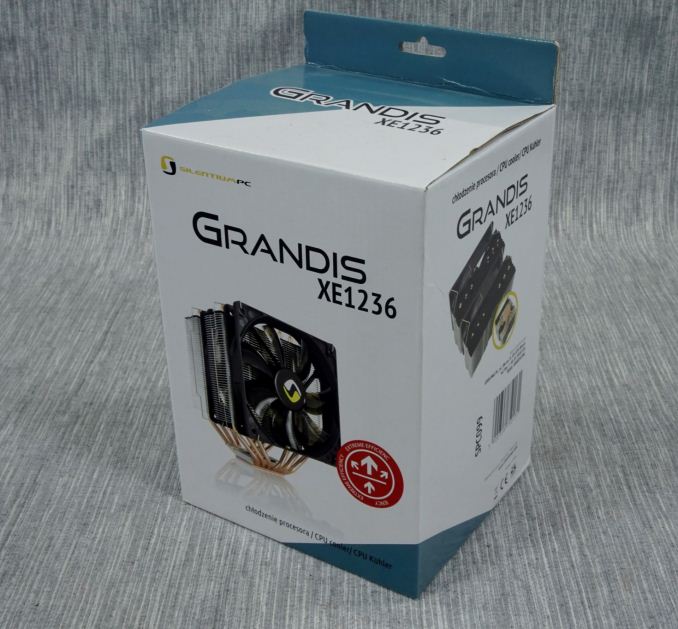
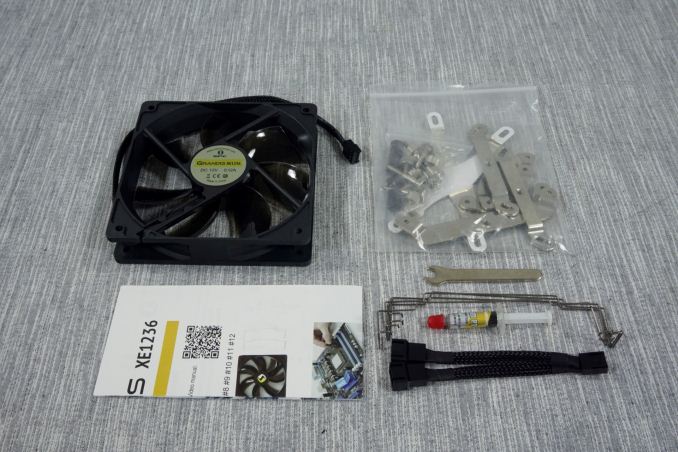
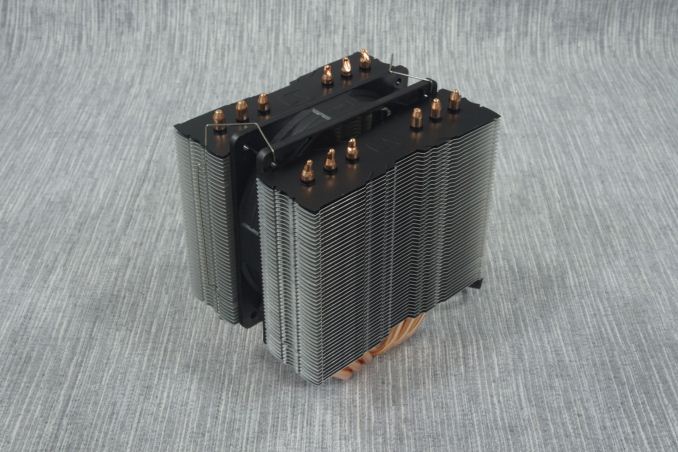
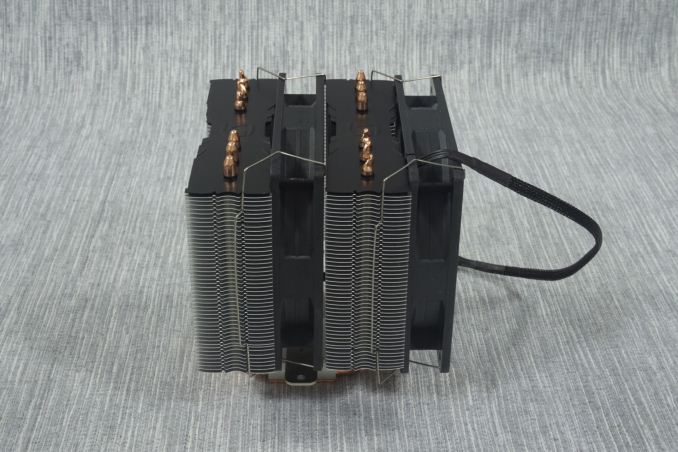
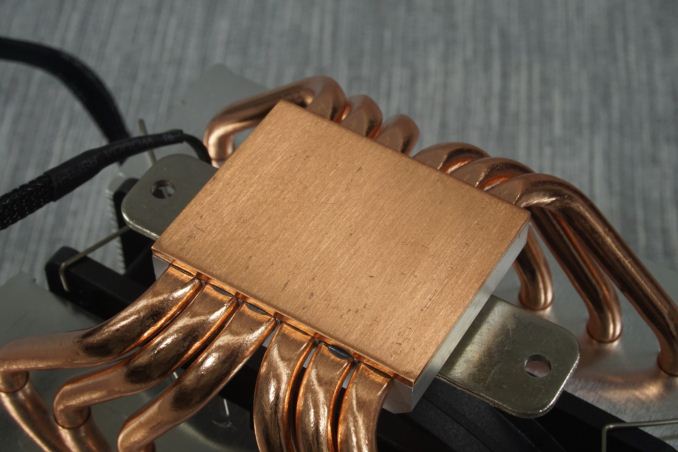








135 Comments
View All Comments
MartenKL - Monday, July 6, 2015 - link
I would of course like to see the testbed updated to have fan/s controlled by thermals, ie something like ASUS Fan Expert. Set for a target temperature and loads in the more realistic range of 15-150 watts. And of course when reducing voltage it should be via PWM and not simply reducing static voltage. The results should then be presented in temperature variance and noise levels/profile.MrSpadge - Monday, July 6, 2015 - link
Good suggestions. I hate those charts with "full fan voltage" and "fan voltage reduced to ..". What I really care about is "how silent can the cooler be for a given temperature / cooling performance?" And "which one cools better at similar noise level".It doesn't help much to see a strong fan with inbearable noise in those charts. Even if someone is interested in such solutions - wouldn't his question rather be "which heatsink performs best with this high-speed fan"? Which would again be something he couldn't answer from this data.
I know making noise based comparisons is difficult. But the raw sound pressure could be accompanied by some subjective remarks regarding the noise spectrum.
Cookiespy - Monday, July 6, 2015 - link
It would be interesting to see how the stock coolers compare to this high performance cooler. I wouldn't pay $80-100 just to see 5degrees improvement.Eidigean - Monday, July 6, 2015 - link
Chips big enough to need these coolers, such as Socket 2011, do not come with stock coolers.meacupla - Monday, July 6, 2015 - link
The stock heatsink cools great and is pretty silent with stock settings in a case with decent airflow, end of story.These kinds of $80 heatsinks are what you want when you overclock, but with the same or lower noise levels.
If you don't overclock, then a $20~25 heatsink can do a 5~20C improvement and keep the computer quieter at the same time too.
Eidigean - Monday, July 6, 2015 - link
What are you, a shill for Intel? The Intel stock heatsinks are the absolute worst. Check out the graphs from this Anandtech article:http://www.anandtech.com/show/6830/cpu-air-cooler-...
Dead last in performance AND noise. Stock heatsink was greater than 30 degrees C hotter, and 20 decibels louder.
meacupla - Monday, July 6, 2015 - link
It says right there in the system specs used to test those coolers..."Intel Core i7-2700K overclocked to 4.4GHz @ 1.4V"
I'm surprised the stock intel heatsink was able to complete the tests.
meacupla - Monday, July 6, 2015 - link
no wait, look, it says the stock heatsink and a low profile heatsink failed on an overclocked i7.Like I said, stock intel heatsink, especially the one with a copper core, works great at stock speeds.
Azurael - Friday, July 17, 2015 - link
I don't know if the stock HSFs have changed since Sandy Bridge, but my 2500k would hit 98+ degrees and throttle under AVX loads with the pathetic little stock thing whilst sounding like a small tornado had developed inside my case (how is it that a 95w CPU comes with an HSF half the size of the ones they used to ship with 65w C2Ds?!)Whichever cheap tower cooler I replaced it with does the job just fine, though. It's been running like a champ at 4.5GHz for near enough 4 years now. (I think it's a Xigmatek SD1283 - I haven't even taken the side off my machine for over a year, those heady days of tinkering and yearly upgrades long since passed.)
bug77 - Monday, July 6, 2015 - link
What, no mention of the weight of each cooler? I think that's a rather important aspect.